Flexibility
What’s most striking about timber cladding is just how flexible it can be. From rustic barns to swish London office buildings and everything in between. Indeed, whereas it was once seen just as an option for sheds and outhouses, it is now seen as a legitimate option for luxury housing and modern offices due to its unique combination of sustainable sourcing, natural looks, low impact and natural insulation, which, of course, can help lower your projet’s energy consumption.
Timber Species
There’s a huge variety of timber species that are suitable for cladding. Here we outline the main ones, although please get in touch if you’d like something more unusual – we’re always ready to help.
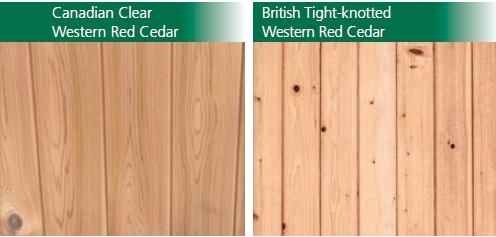
Cedar:
Cedar cladding is probably the most popular option and it mainly refers to Western Red Cedar (Thuja plicata), which is usually sourced from Canada. Another option is British grown Cedar, which is not as durable and has more knots.
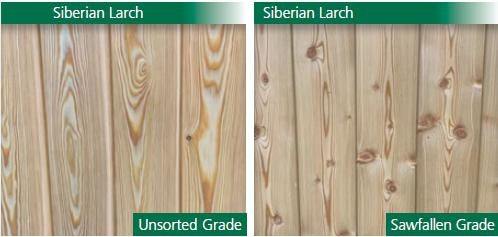
Larch:
Larch cladding mostly refers to Siberian Larch (Larix sibirica), which is a durable species coming from, well Siberia. You will find two quality grades available from most stockists, including us: Unsorted (higher grade) and Sawfallen (lower grade) – as the pictures below demonstrate. Siberian Larch is available in longer lengths than Cedar and is also cheaper due to its greater availability.
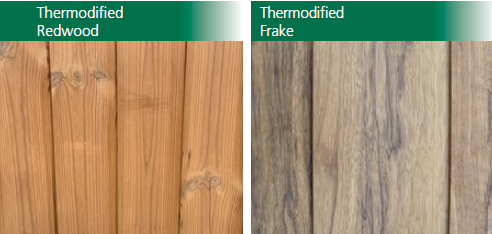
Thermo Woods:
Thermo Wood is actually a process, not a species, but it’s now just commonly referred in the trade as a species given its ubiquity. The process modifies the timber using very high temperature and steam in a controlled chamber so that the cell structure is changed and the end product is more stable and slightly more durable (albeit a bit more brittle too). The most common species is Pine although there’s plenty of Spruce as well – the main difference between them is the size and number of knots (Pine has bigger but fewer knots).
Our Thermodified range includes both Pine and Spruce (softwoods) as well as hardwoods such as Ash (temperate) and Frake (tropical) which offer even less or smaller knots so that Frake is practically called a clear thermo wood. And finally there’s newcomer Abodo – a clear pine that offers high durability, clear boards (no knots) as well as the increased stability of all thermodified timbers.
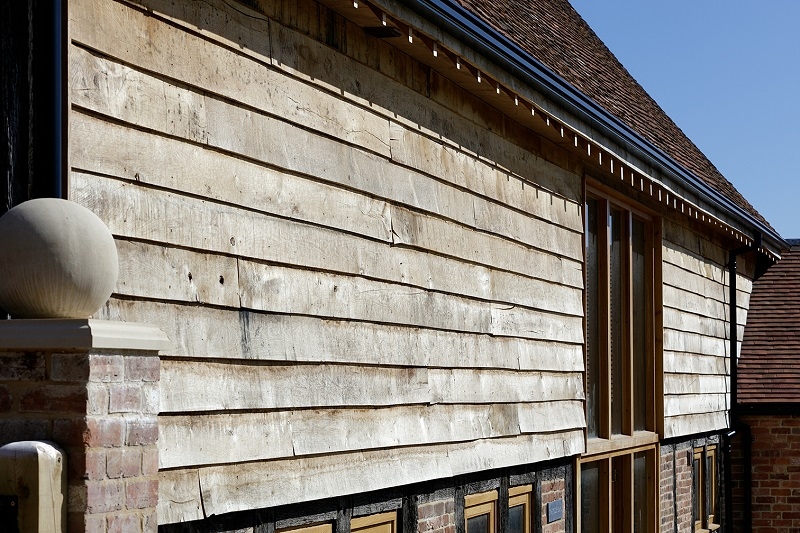
Oak
Popular with both rustic and modern country buildings such as barn conversions, car ports and oak framed buildings, oak cladding is usually offered as traditional feather edge profile, where fixings can be hidden. Sometimes the appeal of the inimitable oak is so high that designers and end-users specify “waney edge” cladding, where one side of the cladding board still keeps the bark visible.
Be aware that although Oak is a durable species and therefore suitable as a long-lasting cladding species, it is not famous for its stability! Oak tends to move as it weathers so unless there’s good ventilation and fixing, it is likely some boards will warp. Still, it is part of its character appeal and most think it is well worth the investment.
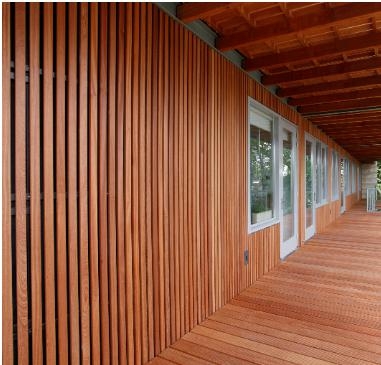
Tropicals
There still is a largely undiscovered world of tropical timber species in cladding projects in the UK, which is curious because there are so many options that are both available and suitable for this end. Some of them include Cumaru, Ipe, Pituca and Iroko. For further information, please give us a call.
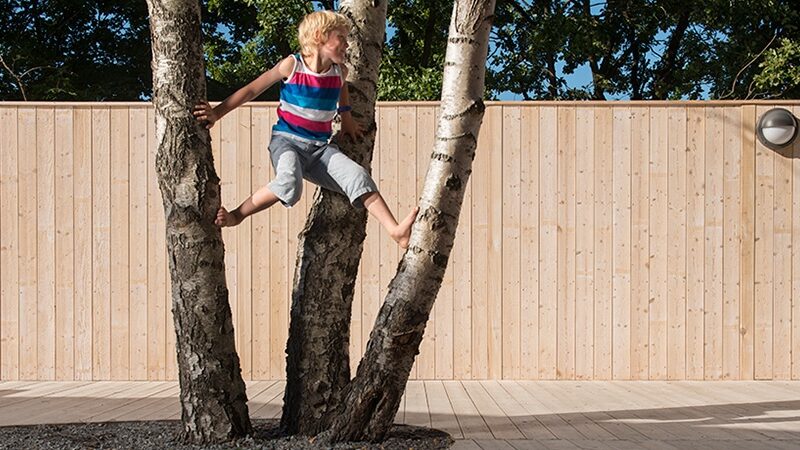
OrganoWood
This is a new breed of modified timber where high quality Swedish Pine is given extra protection through a treatment with Silica, which is a natural and inert material. The end result is an upgraded cladding which, without any biocide chemicals, will last longer, weather to grey quicker and be more resistant to fire – no wonder it’s a favourite of schools and playgrounds!
Profiles
The profile of timber cladding is just as important as its laying style – how it’s fitted (vertical or horizontal, more or less gaps, etc) and how it sits on the property. We stock a wide range of timber species and cladding profiles and can also offer custom-made ones to suit your individual design requirements. When it comes to profile preference, it can vary tremendously from person to person, but the most popular styles are as follows:-
Shiplap – A profile with a neat finish where each board sits just behind the bottom edge of its adjacent cousin.
Tongue & Groove – A flat face design with no overlapping that is generally more popular in contemporary housing. Also available with “V” edges for more dramatic effect!
Feather Edge – With this profile, the boards are tapered and offer a definitively rustic aesthetic that lends itself well to barns and rural homes.
Our wide variety of timbers for cladding is suitable for both large scale commercial buildings as well as small domestic properties and even garden buildings. We also stock lengths up to 6m and offer a range of treatment options: from performance and preservation to purely aesthetic ones.

Weathering
Just like your skin, every timber species will change colour when exposed to the sun for prolonged periods of time without any protection. The effect of the sun, rain and wind is called weathering and it refers to the natural process where the surface face of the timber cladding gradually fades and becomes silvery grey. This is superficial only and most people actually enjoy both the transition and the final result of the weathering process. However, if you wish to delay or prevent this process, that’s also possible by protecting your timber facade with stains or paints of different types, colours and levels of opacity.
Treatments
Whilst timber cladding should not require any potentially harmful chemical preservatives to keep it looking and acting its best for many years to come, most timber species can take extra coats of stain, oil or varnish that preserve its organic beauty for a little longer. Leave it as nature intended and your cladding will eventually weather into a gorgeous silver-grey, but if you prefer we can treat the timber so that it maintains its vigour or perhaps creates a different look entirely.
We offer staining, painting, and even charring and burnt treatments that lend the wood a subtle damaged quality which can look particularly impressive in rustic themed properties including restaurants and barn conversions. We also offer fire protection treatments for most species of wood (to euroclass B).
Corner Detailing
Corner detailing is an important area of fixing detail, not just aesthetically but functionally, to ensure adequate protection against water. Some examples of typical corner details can be seen below.
Whatever your design preference, we can deliver corner boards along with your chosen cladding planks.
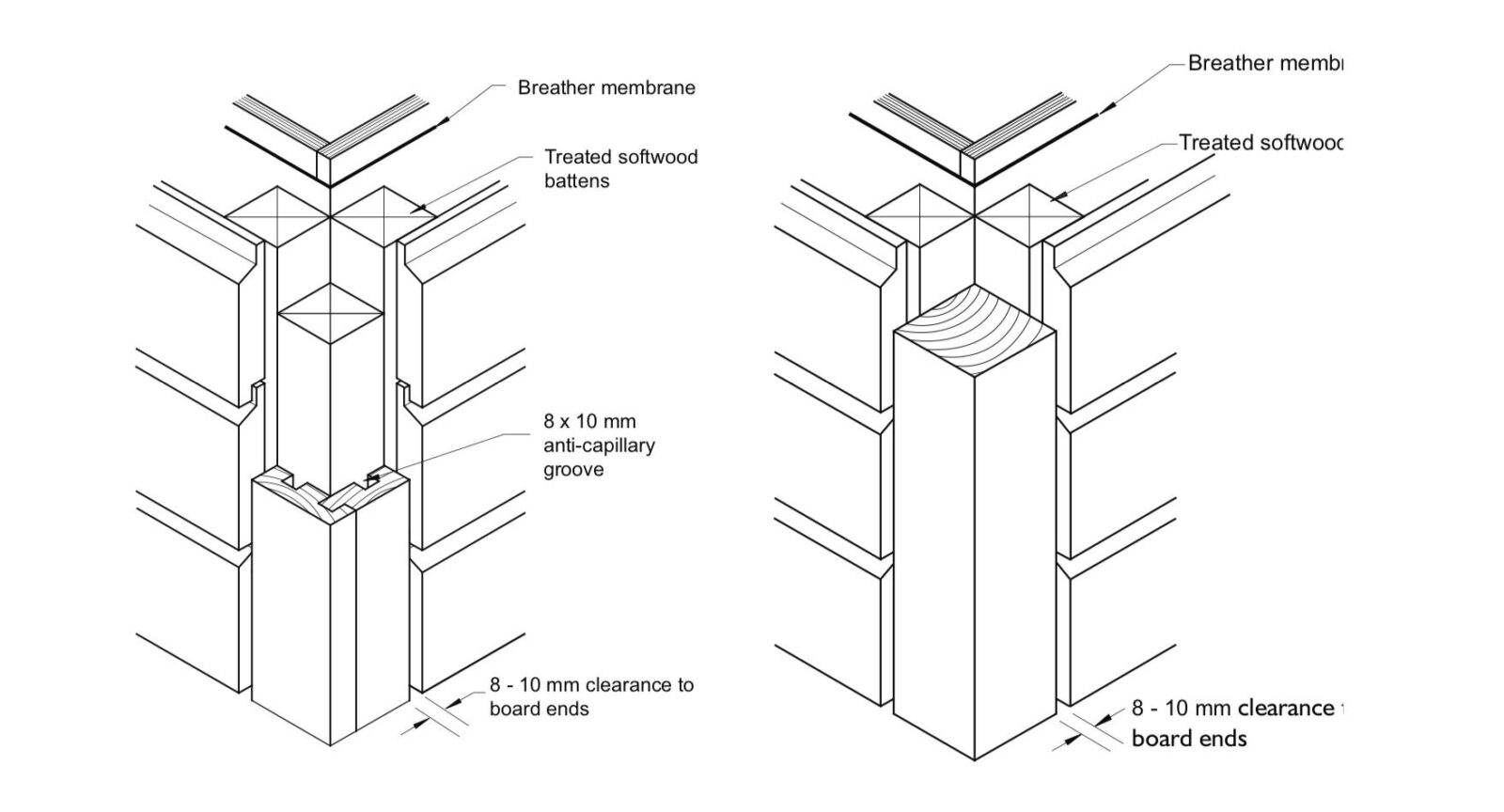
Fixing
Timber cladding is really easy to fit and installation doesn’t require any special or difficult machinery. However, it is also very important to get it right as poor detailing and fitting can create problems which could become unsightly or shorten its life span. With timber that is exposed to the elements such as cladding and decking, sturdy fixings as well as good ventilation are paramount. You can find detail guidance from specialist websites such as TRADA and TDCA but below are some main points to help you along the way.
For strong and stable timber cladding, it’s important to fix each board firmly and correctly. We would always suggest double face fixings at each batten intersection, with
stainless screw fixings that are at least 2.5 times the thickness of your cladding board. The screws should also be fixed a minimum of 20mm from the end of the board to prevent any potential splitting. On thicker woods, it’s usually good practice that all fixing points should be pre-drilled and allow for a 2mm oversize.
When fixing, the moisture content of the wood should be 16% ± 4% unless using green oak.
If you are using green oak cladding boards, prepare fixing points oversized by 4mm and use fixings with washers or large heads for extra security since the boards are likely to move as they weather in place.
The building material of the past and the future
Timber cladding not only offers a warm and natural alternative to brick that is robust, safe and flexible but it is also the most sustainable building product available. Over 97% of the softwood timber used in the UK comes from Europe, where the forest area is increasing by the equivalent of 90 football pitches every hour. It’s the carbon sink factor, however, that might just be the feather in the cap of this naturally durable material because it actually absorbs more carbon than it generates!
So, if you’re ready to join the cladding club, contact us today to help us deliver the solution that transforms your construction project into a beautiful and sustainable reality.
Cladding profiles
Fire treatments
Cedar cladding
Larch cladding
ThermoWood cladding
Frake cladding
Chestnut cladding
OrganoWood cladding
WPC cladding
Oak cladding
SilverLuxe cladding
Cladding related insights
Timber cladding is an increasingly popular option for properties in the UK. From new build homes to commercial renovations, opting...
Looking for a timber species which is perfect for cladding? You cannot go wrong with Cedar. Renowned for its durability,...
The UK weather may seem challenging for outdoor timber with its mix of rain and occasional heatwaves. Yet, by choosing...
As one of the great native timbers of the UK and most of Europe, we adore Larch. At EcoChoice, it...
Cedar is widely known for its beautiful scent and as a feature in wintery woodland landscapes. In the timber industry,...
Whether you are a construction professional, an architect or a DIY enthusiast, if you are planning a cladding project we...
